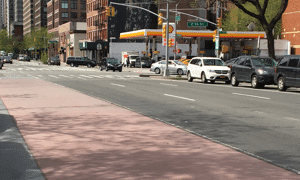Case Study
1st Avenue, New York City, United States
 Challenge
Challenge
Paving and maintaining New York City streets is unusually challenging. Many of the streets are in poor condition with aging concrete and old, delicate utility infrastructure underneath. In 2012, the New York City Department of Transportation (NYCDOT) was struggling to find a solution for 50 blocks of 1st Avenue. Replacing the 45 cm (18 in) concrete pavement was prohibitive in cost and time. Thin overlays helped, but they only added a few years of life before further remediation was needed.
Looking for a solution, NYCDOT contacted Axeon Specialty Products. Axeon suggested their High-Performance Thin Overlay (HPTO) mix design with a PG 76-28 modified asphalt binder. In consultation with Kraton, Axeon proposed an alternative using HiMA. With a start date of September 2012, the NYCDOT paved two blocks, each with the two binders. A year later, no rutting or cracking was observed. Looking for the best long-term solution, NYCDOT opted for the HiMA binder.
Paved in fall 2013, the overall project started with 1.3 cm (.5 in) micro-milling for a smooth surface with extensive crack sealing. A crack attenuating grid was attached with PG 76-28 binder followed by 3.8 cm (1.5 in) of HPTO/HiMA mix with a warm mix additive. A total of 11,000 tons was placed over 53 city blocks at night, with paving completed in only three weeks. The mix was fixed at about 149°C (300°F), and 95 percent density was ultimately achieved.
By end of 2019, the pavement is still in excellent condition, and NYCDOT stated that performance exceeded their expectations. By using the HPTO mixture featuring HiMA technology, they were able to leave the deteriorated concrete pavement in place while fully rehabilitating the surface. As a result, NYCDOT saved over 80 percent of what it would cost to remove and replace the old pavement.
